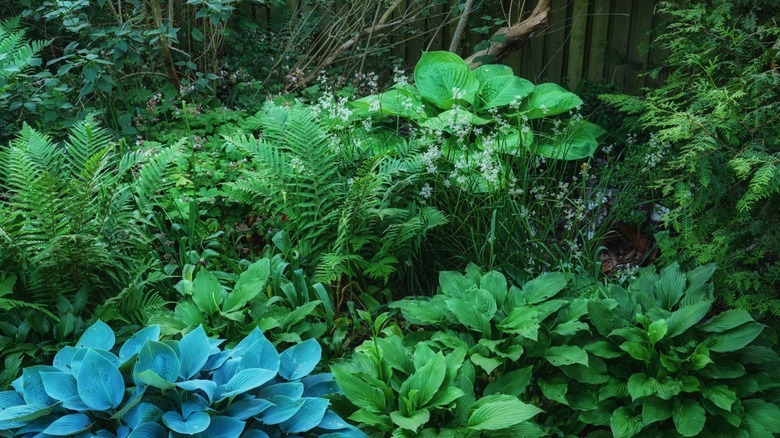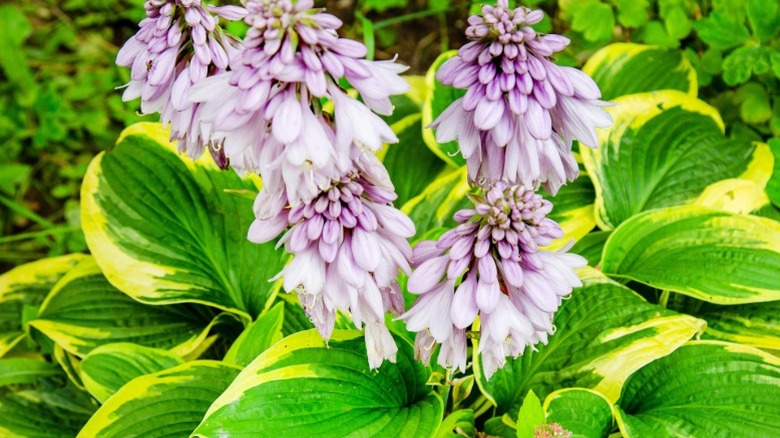The Stunning Variety Of Hostas You Can Plant Under Trees & Shrubs For Ground Coverage
Grass may suffer in the shade, but Hosta 'Golden Tiara' shines under trees and shrubs, filling bare ground with bold color and texture. Its low mounds spread naturally, transforming dark corners into lush, finished spaces. Hardy and adaptable, this perennial brings depth and understated color to shady gardens with very little effort.
Hostas (Hosta spp.), part of the Asparagaceae family, are native to China, Japan, Korea, and parts of Russia. With more than 2,000 cultivars, including 'Golden Tiara,' the genus offers endless options for shady gardens where trees and shrubs are plentiful. Leaves come in green and gold, along with eye-catching variegated types; some edged in yellow or white and others marked with pale centers. Sizes range from dwarfs that stand shorter than 4 inches to giants exceeding 28 inches, giving gardeners choices for tiny borders or sweeping displays.
Among shade-lovers, 'Golden Tiara' stands out. It reaches about 16 inches in height and spreads up to 38 inches, forming tidy clusters with minimal upkeep. Its vivid variegation, with bright yellow edges surrounding deep green centers, adds a striking pop of color to shaded corners. In late summer, slender stalks lift pale lavender flowers above the foliage, adding gentle height and seasonal interest. Adaptable across many climates, 'Golden Tiara' is a reliable, low-effort pick for shady spots that need beauty and coverage. Plus, it doubles as a dependable ground cover to help choke out unwanted weeds in tricky, shaded areas.
Best conditions for hosta 'Golden Tiara' plants in your garden
'Golden Tiara' thrives in morning sun or dappled shade, making it flexible for different garden settings. Like other hostas, it benefits from winter dormancy and temperatures below 40 degrees Fahrenheit for a couple of months, which encourage healthy spring growth. The foliage naturally dies back in late fall when temperatures drop to around 28 degrees Fahrenheit, marking the start of its rest period before regrowth.
This cultivar prefers rich, moist soil with plenty of organic matter and good drainage. Compost, peat, or leaf mold improve soil structure and keep roots happy. While tolerant of many soil types, soggy conditions in winter can rot rhizomes, so drainage is key. A soil test every three to five years helps determine when to amend or fertilize. Spring planting is ideal, though summer planting works with consistent watering. Browning leaf tips usually point to sunscald, but shifting the plant to more shade or upping moisture often solves the problem.
Hardy in USDA Hardiness zones 3 through 9, 'Golden Tiara' fits into a wide range of gardens. Its soft-hued lavender flowers attract bees, butterflies, and hummingbirds. These blossoms also bring a touch of movement and life to shaded beds and rock gardens. Watch for pests such as slugs, snails, deer, rabbits, and voles. Leaf spot is uncommon, though crown or root rot can appear in soggy soils. Viruses such as Hosta Virus X or tomato ringspot require immediate removal of affected plants. Anthracnose may cause white-spotted, brown-edged leaves, best managed by trimming damaged foliage. Wind and hail can tear leaves, and since all parts of hosta are toxic to cats, dogs, and horses, placement should account for pet safety. Given the right conditions, this fast-growing shade plant will quickly fill your yard with color.

